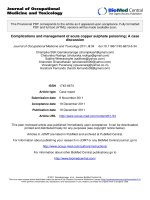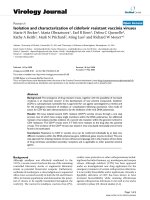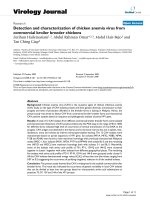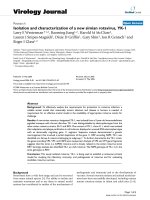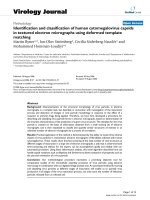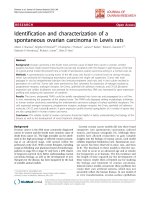Báo cáo hóa học: " Synthesis and Characterization of Monodispersed Copper Colloids in Polar Solvents" pdf
Bạn đang xem bản rút gọn của tài liệu. Xem và tải ngay bản đầy đủ của tài liệu tại đây (482.13 KB, 6 trang )
NANO EXPRESS
Synthesis and Characterization of Monodispersed Copper
Colloids in Polar Solvents
Wei Yu Æ Huaqing Xie Æ Lifei Chen Æ
Yang Li Æ Chen Zhang
Received: 5 November 2008 / Accepted: 27 January 2009 / Published online: 19 February 2009
Ó to the authors 2009
Abstract A chemical reduction method for preparing
monodispersed pure-phase copper colloids in water and
ethylene glycol has been reported. Owing to the reduction
property of ethylene glycol, the reaction rate in ethylene
glycol is higher than that in water. In addition, the amount
of reducing agent can be reduced largely. Ascorbic acid
plays roles as reducing agent and antioxidant of colloidal
copper, due to its ability to scavenge free radicals and
reactive oxygen molecules. Thermogravimetric results
reveal that the as-prepared copper nanoparticles have good
stability, and they begin to be oxidized at above 210 °C.
Polyvinyl pyrrolidone works both as size controller and
polymeric capping agents, because it hinders the nuclei
from aggregation through the polar groups, which strongly
absorb the copper particles on the surface with coordina-
tion bonds.
Keywords Chemical synthesis Á Monodispersed Á
Copper colloid Á Polyvinyl pyrrolidone
Introduction
In recent years, there is an increasing interest in the
research on metal colloids due to the multiple applications
involving their physical and chemical properties [1–3]. For
example, the magnetic fluids made of Fe metal particles
have higher magnetization in comparison with the fluids
containing magnetic-iron oxide (Fe
3
O
4
or c-Fe
2
O
3
)[4]. Co
nanoparticles in a colloidal solution can assemble into
highly constrained linear chains along the direction of the
magnetic field, and the magnetic-field-induced chains
become floppy after removal of the field, folding into three-
dimensional coiled structures upon gentle agitation [5]. Co
nanoparticles dispersed in monopolar solvents are effective
for enhancing the heating rates of xylene by microwaves,
and the smaller particles exhibits greater levels of micro-
wave absorption enhancement than nanoparticles of larger
diameters [6]. Pt and Ag colloids in aqueous solution and
organic solvents can be effectively used for the hydroge-
nation of cis, cis-1,3-cyclooctadiene [7]. The colloidal
solution of PtRu nanoparticles has catalytic activity for
methanol oxidation [8]. Colloidal silver and copper nano-
particles exhibit characteristic spectra due to surface
plasmon resonance [9]. Copper colloids embedded in oxide
glasses strongly modify their optical properties, making
these composite materials useful for resonant-type nonlin-
ear optical materials for photonic devices [10]. Copper
nanoparticles are good additive of nanofluid, which is
produced by dispersing nanoparticles into conventional
heat transfer fluids, and nanofluids are proposed as the next
generation heat transfer fluids due to the fact that their
thermal conductivities are significantly higher than those of
the base liquids [11–13].
During the past few decades, many methods have been
developed for the synthesis of metal colloids, such as laser
ablation technique [14], photochemical route [15], micro-
wave dielectric heating [16], and thermal decomposition
method [17]. In contrast with noble metals, such as Ag, Au,
and Pt, pure metallic copper usually cannot be obtained
easily via the reduction of simple copper salts in aqueous
solution. Despite zero valence copper initially forming the
polar solvents ultimately, it has been found that the zero
valence copper can easily transform into oxides in those
W. Yu Á H. Xie (&) Á L. Chen Á Y. Li Á C. Zhang
School of Urban Development and Environmental Engineering,
Shanghai Second Polytechnic University, Shanghai 201209,
China
e-mail:
123
Nanoscale Res Lett (2009) 4:465–470
DOI 10.1007/s11671-009-9264-3
solvents with high dipole moments under ambient condi-
tions [18]. So a simple chemical reduction strategy for the
synthesis of copper colloids at mild conditions is highly
desired. However, nanoparticles tend to be fairly unstable
in solution and therefore, special precautions have to be
taken to avoid their aggregation or precipitation during the
preparation of such colloidal particles in solution. To
obtain stable colloids, the most effective and common
strategy is the introduction of a protective agent in the
reaction system [19]. Here, we report a facial chemical
reduction method to synthesize monodispersed copper
colloids in polar solvent without protective gas. Two
reaction media, water and ethylene glycol, were used as
solvents, and the influences of solvents on reaction rate, the
amount of reducing agent and reaction mechanism were
discussed. The roles of polyvinyl pyrrolidone (PVP) and
ascorbic acid were investigated.
Experimental
Preparation of Copper Colloids
Copper sulfate, ascorbic acid, PVP-K30 (Mw = 40,000),
and ethylene glycol (E.G) were purchased from China
Medicine (Group) Shanghai Chemical Reagent Corpora-
tion. All the chemicals were analytical grade and used as
purchased without further purification. In the experiments,
copper colloids were synthesized by two procedures, using
deionized water and E.G as reaction solvents, respectively.
In a typical procedure, a certain amount of PVP and
ascorbic acid was dissolved in the 200 mL 0.2 mmol/L
CuSO
4
aqueous (or E.G) solution under mechanical stir-
ring, and the reaction mixture was kept at 80 °C for some
time. The colloidal suspension was then taken out from the
oil bath and cooled to room temperature. For further
characterization, the colloid was diluted by ethanol and
centrifuged at 8000 rpm for 15 min to separate the parti-
cles from the suspension. The particles separated were then
resuspended in ethanol and the centrifugation was repeated
3 times so as to remove the surfactant. After that, the
precipitates were dried under vacuum overnight and then
collected. The experimental parameters are listed in
Table 1, and the corresponding XRD patterns of the
products prepared at different experimental parameters are
shown in Fig. 2.
Characterization of Copper Nanoparticles
XRD measurements were recorded using a (D8-Advance,
Germany) X-ray diffractometer equipped with a back mono-
chromator operating at 40 kV and a copper cathode as the
X-ray source (k = 0.154 nm). XRD patterns were recorded
from 20°to 80°(2h) with a scanning step of 0.01. The size and
morphology of the Cu nanoparticles were examined by using
transmission electron microscopy (TEM, JEOL 2100F). The
TEM samples were prepared by dispersing the powder prod-
ucts in alcohol by ultrasonic treatment, dropping the
suspension onto a holey carbon film supported on a copper
grid, and drying it in air. A thermogravimetric (TG-DTG,
Netzsch STA 449C) analyzer (sample mass: about 15.0 mg;
atmosphere, flowing dry oxygen; heating rate, 10 K/min) was
used for thermogravimetric analysis.
Results and Discussion
The Influences of Solvents on Reaction Process
Sample 1 and sample 2 were synthesized using water as
solvent, and the reaction time was 6 and 8 h, respectively.
Because ascorbic acid is a weak reducing agent, the reac-
tion rate using water as solvent is slow. The color change
of the reaction process is shown in Fig. 1a. The light blue
reaction system turned to cloudy yellow in 3 h, and then it
became brick red, and after 2 h it became red colloidal.
Figure 2 shows the XRD patterns of samples prepared by
different procedures. When the reaction time was less than
6 h, the product was impure, and it was the mixture of face-
centered cubic (fcc) phase of copper (JCPDS 04-836) and
cubic phase of Cu
2
O (JCPDS 05-0667), and copper was the
main product. The XRD analysis results coincided with the
experimental phenomena. When the reaction time was over
8 h, the product was pure-phase copper.
Comparing to the reaction rate using water as solvent,
the rate using E.G was higher, and the color change of the
Table 1 Comparison of results from the two reaction systems and different experimental parameters
Sample No. Solvent CuSO
4
(mmol/L) PVP-K30 (mmol/L) Product Ascorbic acid/Cu
2?
(mol/mol)
Reaction time Mean size (nm)
1 Water 0.2 0.5 Cu
2
O ? Cu 20 6 h –
2 Water 0.2 0.3 Cu 20 8 h 7 ± 3
3 Water 0.2 0.5 Cu 20 8 h 4 ± 1
4 E.G 0.2 0.3 Cu 8 1 h 6 ± 3
5 E.G 0.2 0.5 Cu 8 1 h 3 ± 1
466 Nanoscale Res Lett (2009) 4:465–470
123
reaction process is shown in Fig. 1b. In 15 min, the initial
precursor solution with light blue color changed to light
brown, red, and black. The reaction could complete in 1 h,
and the product was phase-pure. The higher rate using E.G
attributed to the reduction property of E.G. E.G was a weak
reducing agent, and it could reduce Cu
2?
to Cu
?
, which
was confirmed by some experimental facts [16, 20]. Due to
the united deoxidization of ascorbic acid and E.G, the
reaction using E.G was fast, and Cu
2
O was not detected in
the procedure. In addition, the amount of reducing agent
ascorbic acid could be reduced largely. When water was
solvent, the molar ratio of ascorbic acid/Cu
2?
was up to 20.
For E.G reaction system, the molar ratio of ascorbic acid/
Cu
2?
was 8.
The Role of Ascorbic Acid as Reducing Agent
and Antioxidant of Colloidal Copper
To prevent oxidation, the reaction solutions were carefully
deoxygenated and the entire processes were performed
under rigorous protection of inert gas in many reported
studies [21]. During the synthesis process, ascorbic acid
plays a role as reducing agent, and in the storage, excessive
ascorbic acid is essential to avoid oxidation of copper
nanoparticles. The antioxidant properties of ascorbic acid
come from its ability to scavenge free radicals and reactive
oxygen molecules [22], accompanying the donation of
electrons to give the semi-dehydroascorbate radical and
dehydroascorbic acid (Eq. 1). Therefore, ascorbic acid
plays dual roles of reducing agent and antioxidant of
copper nanoparticles. The reaction can complete without
protective gas. The TG-DTG curves of the prepared
copper nanoparticles using E.G as solvent are shown in
Fig. 3. The results show that copper nanoparticles begin to
be oxidized at above 210 °C, indicating that copper
nanoparticles have good stability. From 210 to 400 °C, the
oxidation rate is slow. When temperature is further
increased, the oxidation rate becomes higher. When the
temperature reaches 650 °C, the oxidation is completed
with the weight increment of 25.10%, and the oxidation
product is CuO (the theoretical weight increment 25.0%).
The TG-DTG curves of the prepared copper nanoparticles
using water is similar to that using E.G.
The Role of PVP as Size Controller and Protective
Agent of Copper Colloid
PVP is always used as the dispersant to prepare nanomate-
rials and the stabilizer of metal colloids, and the size and
Fig. 1 The color change of the
reaction process in water
medium (a) and E.G medium
(b)
O
O
OH
HO
OH
OH
H
H
O
O
O
HO
OH
OH
H
H
O
O
O
O
OH
OH
H
H
-H
.
-H
.
(1)
L-Ascorbic acid
Dehydroascorbic acid
Nanoscale Res Lett (2009) 4:465–470 467
123
shape of nanomaterials depends strongly on the solution
concentration of PVP [23, 24]. Figure 4 shows that when
water was the reaction solvent and the concentrations of PVP
were 0.3 or 0.5 mmol/L, the copper nanoparticles were
approximately spherical with the mean diameter about 7 or
4 nm, respectively. The influence of PVP on the size of
copper nanoparticles in E.G was similar to that in water.
When the concentration of PVP was 0.3 or 0.5 mmol/L, the
copper nanoparticles were monodispersed in E.G reaction
system, and the mean diameters were about 6 or 3 nm,
respectively, indicating that the increasing of PVP concen-
tration attributes to the smaller dimension particles (Fig. 5).
The mechanism of the effect of PVP on size and shape
of nanomaterials has been discussed in some literatures
[25–27]. PVP has the structure of a polyvinyl skeleton with
nitrogen and oxygen polar groups, and the polar group
donates lone-pair electrons forming a coordinative inter-
action with copper ions, thus creating the Cu
2?
–PVP
complex compound (Eq. 2) in the solution [15, 27]. When
water was the reaction medium, the reaction time was not
over 6 h, according to the XRD analysis, the product was
impure. The fact indicated that Cu
2?
–PVP complex was
reduced to Cu
?
–PVP firstly, and then Cu
?
reacted with
OH
-
to form Cu
2
O, due to the existence of enough OH
-
,
so the color of reaction system was yellow when the
reaction time was 3 h. The further reduction of Cu
?
formed
the pure copper nanoparticle. The coordination action
between PVP and Cu
?
prevented the agglomeration of the
copper nanoparticles (Eq. 3). Due to the higher rate using
E.G as reaction medium, no intergradation product Cu
2
O
was detected. According to the above analysis, PVP acted
as the polymeric capping agents and size controller. It
hinders the nuclei from aggregation through the polar
100 200 300 400 500 600 700 800
90
100
110
120
130
-0.10
-0.05
0.00
0.05
0.10
0.15
0.20
Derivate Mass
TG
Mass (%)
T (°C)
DTG
Fig. 3 Typical TG-DTG curves of Cu nanoparticles obtained in E.G
medium
Fig. 4 Typical TEM images of Cu nanoparticles obtained in water
medium. a Sample 2, b Sample 3
Fig. 2 XRD pattern of the products prepared at different experimen-
tal parameters
468 Nanoscale Res Lett (2009) 4:465–470
123
groups, which strongly absorb the copper particles on the
surface with coordination bonds.
Conclusions
In this letter, two monodispersed copper colloids in water
and E.G have been prepared. In order to obtain pure-phase
copper colloid in water, the reaction time of 8 h is essential;
otherwise the products will be the mixture of face-centered
cubic phase of copper and cubic phase of Cu
2
O. Comparing
to the reaction rate using water, the rate in E.G was higher,
due to the reduction property of E.G. In addition, the amount
of reducing agent ascorbic acid could reduce largely.
Ascorbic acid plays roles as reducing agent and antioxidant
of colloidal copper, due to its ability to scavenge free radi-
cals and reactive oxygen molecules. The TG-DTG curves of
the prepared copper nanoparticles show that copper nano-
particles have good stability, and they begin to be oxidized at
above 210 °C, and the oxidation product is CuO. The size of
copper particles depended on the concentration of PVP, and
the increasing of PVP concentration attributed to the smaller
dimension particles. PVP works both as size controller and
polymeric capping agents, because it hinders the nuclei from
aggregation through the polar groups, which strongly absorb
the copper particles on the surface with coordination bonds.
The work proves that it is possible to obtain monodispersed
pure-phase copper colloids in polar solvents through care-
fully selecting experimental conditions.
Acknowledgments The work was supported by the National High
Technology Research and Development Program of China
(2006AA05Z232), Shanghai Educational Development Foundation and
Shanghai Municipal Education Commission (08CG64), the Excellent
Young Scholars Research Fund of Shanghai (No.RYQ307007) and the
Program for Professor of Special Appointment (Eastern Scholar) at
Shanghai Institutions of Higher Learning.
Fig. 5 Typical TEM images of Cu nanoparticles obtained in E.G
medium. a Sample 4, b Sample 5
N
CH-CH
2
O
Cu
2+
N
CH-CH
2
O
N
CH-CH
2
O
Cu
2+
N
CH-CH
2
O
Cu
2+
n
+
n
+
n
n
Vc
Water / EG
(2)
N
CH-CH
2
O
N
CH-CH
2
O
Cu
+
N
CH-CH
2
O
Cu
+
N
CH-CH
2
O
N
CH-CH
2
O
Cu
N
CH-CH
2
O
Cu
n
+
n
n
n
+
n
n
(3)
Nanoscale Res Lett (2009) 4:465–470 469
123
References
1. S.U. Son, S.L. Lee, Y.K. Chung, S.W. Kim, T. Hyeon, Org. Lett.
4, 277 (2002). doi:10.1021/ol017043k
2. A. Lagunas, C. Jimeno, D. Font, L. Sola, M.A. Pericas, Langmuir
22, 3823 (2006). doi:10.1021/la053016h
3. Y.J. Song, H. Modrow, L.L. Henry, C.K. Saw, E.E. Doomes,
V. Palshin, J. Hormes, C.S.S.R. Kumar, Chem. Mater. 18, 2817
(2006). doi:10.1021/cm052811d
4. X.X. Zhang, B.X. Qin, G.H. Wen, Y.S. Kwok, K.K. Fung, Mater.
Sci. Eng. C 16, 119 (2001). doi:10.1016/S0928-4931(01)00285-5
5. G.J. Cheng, D. Romero, G.T. Fraser, A.R. Hight Walker, Lang-
muir 21, 12055 (2005). doi:10.1021/la0506473
6. A. Holzwarth, J.F. Lou, T.A. Hatton, P.E. Laibinis, Ind. Eng.
Chem. Res. 37, 2701 (1998). doi:10.1021/ie970819u
7. S.H. Choi, Y.P. Zhang, A. Gopalan, K.P. Lee, H.D. Kang,
Colloids Surf. A Physicochem. Eng. Asp. 256, 165 (2005). doi:
10.1016/j.colsurfa.2004.07.022
8. Y. Shimazaki, Y. Kobayashi, S. Yamada, T. Miwa, M. Konno,
J. Colloid Interface Sci. 292, 122 (2005). doi:10.1016/j.jcis.2005.
05.052
9. G. Suyal, Thin Solid Films 426, 53 (2003). doi:10.1016/
S0040-6090(02)01294-4
10. B. Macalik, L. Krajczyk, T. Morawska-Kowal, Phys Status Solidi
4, 761 (2007). doi:10.1002/pssc.200673837
11. X.F. Li, D.S. Zhu, X.J. Wang, N. Wang, J.W. Gao, H. Li,
Thermochim. Acta 469, 98 (2008). doi:10.1016/j.tca.2008.01.008
12. M.S. Liu, M.C.C. Lin, C.Y. Tsai, C.C. Wang, Int. J. Heat Mass
Transf. 49, 3028 (2006). doi:10.1016/j.ijheatmasstransfer.2006.
02.012
13. H. Bonnemann, S.S. Botha, B. Bladergroen, V.M. Linkov, Appl.
Organomet. Chem. 19, 768 (2005). doi:10.1002/aoc.889
14. T. Tsuji, K. Iryo, Y. Nishimura, M. Tsuji, J. Photochem. Photo-
biol. A 145, 201 (2001)
15. S. Giuffrida, L.L. Costanzo, G. Ventimiglia, C. Bongiorno, J.
Nanopart. Res. 10, 1183 (2008). doi:10.1007/s11051-007-9343-2
16. K. Patel, S. Kapoor, D.P. Dave, T. Mukherjee, J. Chem. Sci. 117,
53 (2005). doi:10.1007/BF02704361
17. D.K. Lee, Y.H. Kim, X.L. Zhang, Y.S. Kang, Curr. Appl. Phys. 6,
786 (2006). doi:10.1016/j.cap.2005.04.040
18. J.G. Yang, Y.L. Zhou, O. Takeshi, R. Ichino, M. Okido, J. Mater.
Sci. 42, 7638 (2007). doi:10.1007/s10853-007-1899-9
19. Y.L. Luo, Mater. Lett. 61, 1873 (2007). doi:10.1016/j.matlet.2006.
07.166
20. L.J. Fu, J. Gao, T. Zhang, Q. Cao, L.C. Yang, Y.P. Wu, R. Holze,
H.Q. Wu, J. Power Sources 174, 1197 (2007). doi:10.1016/
j.jpowsour.2007.06.030
21. X.Y. Song, S.X. Sun, W.M. Zhang, Z.L. Yin, J. Colloid Interface
Sci. 273, 463 (2004). doi:10.1016/j.jcis.2004.01.019
22. C.W. Wu, B.P. Mosher, T.F. Zeng, J. Nanopart. Res. 8, 965
(2006). doi:10.1007/s11051-005-9065-2
23. L. Huang, F. Peng, H. Yu, H.J. Wang, Mater. Res. Bull. 43, 3047
(2008). doi:10.1016/j.materresbull.2007.11.011
24. A. Gniewek, A.M. Trzeciak, J.J. Zio
´
łkowski, L. Kepi’nski, J.
Wrzyszcz, W. Tylus, J. Catal. 229, 332 (2005). doi:10.1016/j.jcat.
2004.11.003
25. X. Zhang, Y. Xie, F. Xu, X.H. Liu, D. Xu, Inorg. Chem. Com-
mun. 6, 1390 (2003). doi:10.1016/j.inoche.2003.09.002
26. Z. Zhang, B. Zhao, L. Hu, J. Solid State Chem. 121, 105 (1996).
doi:10.1006/jssc.1996.0015
27. I. Haas, S. Shanmugam, A. Gedanken, J. Phys. Chem. 110, 16947
(2006). doi:10.1021/jp064216k
470 Nanoscale Res Lett (2009) 4:465–470
123
